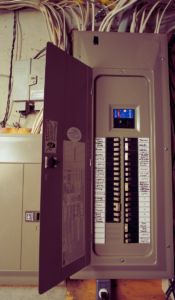 Most homeowners don’t think about their electrical panel.
Most homeowners don’t think about their electrical panel.
They should.
Your home’s electrical panel is the control center. It sends power to everything—your lights, fridge, AC, chargers, microwave. It keeps the flow balanced and safe. And when it gets overloaded or outdated, the whole system suffers.
Here’s what you need to know. What the panel does. How to spot problems. Why you might need a service upgrade. And what happens if you wait too long.
Let’s get into it…
What Is an Electrical Panel & Why It Matters
Your electrical panel is the box in your garage or hallway that holds your breakers. Those breakers act like switches. They control how much electricity moves through each part of the house.
Too much power? The breaker flips off. That’s how your system avoids fires or blown wires.
Old homes might still have fuses or 60–100 amp panels. These worked fine when homes had one TV, no AC, and a single rotary phone.
But today? They struggle. You’re asking more of your electrical system than it was ever designed to handle.
Modern homes usually need 150–200 amps to stay safe and powered.
Top 14 Signs You Need to Upgrade Your Electrical Panel
You don’t have to be an electrician to spot the warning signs. If you notice any of the following, it’s time to call in someone who is.
Your Home Is Over 25 Years Old
Older homes weren’t built for today’s electrical demand. If your panel hasn’t been replaced since the Clinton era, start there.
Flickering or Dimming Lights
Do your lights blink when you turn on the microwave? That’s not a ghost. It’s your panel begging for help.
Breakers Trip Frequently
A breaker that flips once is normal. But if it’s happening weekly, your system can’t keep up.
Burning Smell or Scorch Marks
Never ignore a burnt plastic smell near the panel. That’s not just wear and tear—it’s danger.
Buzzing or Crackling Sounds
Electricity should be silent. If you hear buzzing or popping, something’s loose or overheating.
Warm or Hot Panel Surface
Your panel should feel cool. If it’s warm or hot, the wires inside are likely overheating.
Rust, Corrosion, or Water Damage
Moisture and electricity don’t mix. If there’s rust or any sign of water damage, the panel is compromised.
You Still Use a Fuse Box
Fuse boxes are outdated. Period. They’re not safe, and they’re not worth holding onto.
Appliances Don’t Work at Full Power
If your oven takes forever to preheat or your dryer struggles, your system is underpowered.
Breaker Won’t Stay Reset
If a breaker flips off and won’t stay on, the circuit is either overloaded or damaged.
Using Too Many Extension Cords
If you’re constantly plugging in power strips, it means you don’t have enough circuits.
Recent Home Additions or Remodels
New rooms, outlets, or appliances all pull more power. Your panel may need an upgrade to keep up.
You Installed an EV Charger or HVAC Upgrade
Electric vehicle chargers, tankless water heaters, and new HVAC systems need more juice than older panels can deliver.
Insurance or Inspectors Raise Concerns
Some insurers won’t cover homes with certain panels. If an inspector flags yours, don’t wait.
Benefits of Upgrading Your Electrical Panel
 Upgrading your electrical panel isn’t just about fixing a problem. It’s about making your home stronger and safer.
Upgrading your electrical panel isn’t just about fixing a problem. It’s about making your home stronger and safer.
- Fewer risks: Reduce fire hazards and meet code.
- Better performance: Run all your tech without dimming lights or tripped breakers.
- More stability: Keep voltage steady across your home’s electrical system.
- Higher value: Updated panels help with appraisals, inspections, and insurance.
Do You Need 100, 150, or 200 Amp Panel?
Here’s how to think about it.
- 100 amp: Enough for a small home without heavy appliances.
- 150 amp: Works for most average homes.
- 200 amp: Needed if you have central air, electric heat, EV charger, or plan to expand.
Think about what your home needs now, and what it might need in five years. A 200 amp panel gives you breathing room.
Common Upgrade Scenarios (Real-Life Examples)
You don’t need to be building a mansion to need a panel upgrade. It happens more often than you think.
- Renovating the kitchen? Your new stove and outlets could overload the current panel.
- Adding a home office or hot tub? That’s a load your old system might not handle.
- Installing solar or EV charger? You’ll need a service upgrade to support the new flow.
Can You DIY a Panel Upgrade? (Spoiler: No)
 Don’t mess with this.
Don’t mess with this.
Panel upgrades involve permits, inspections, and serious electrical work. One wrong wire can ruin your house or worse.
That’s why you need a licensed electrician. Someone who knows the codes. Someone with experience. Someone who shows up ready.
If you’re in Ft. Worth, TX or nearby, Comfort Experts has your back. They’ve been doing this for decades. Their team lives up to the name.
Electrical genius. That’s not just a line. That’s how they work.
FAQs About Electrical Panel Upgrades
How long does an upgrade take?
Most panel upgrades take one full day. Power will be off for part of it, but good electricians keep downtime minimal.
Do I need to upgrade for a new appliance?
Maybe. If your panel is already at capacity, yes. Large appliances like HVAC systems or electric stoves often push the limits.
Is it covered by insurance?
Sometimes. If there was storm damage or fire risk, possibly. But upgrades due to age or power demands usually aren’t covered.
What’s the difference between a subpanel and main panel?
The main panel connects to your utility service. A subpanel splits off from the main panel to power a section of the home or outbuilding.
Final Thoughts: Don’t Wait Until It’s Too Late
Electrical panels don’t last forever. And when they go, they don’t whisper.
If your home has signs, listen. Don’t wait for the flicker to turn into a blackout, or worse, a fire.
Comfort Experts is here to help. If you’re in Ft. Worth or nearby, call and schedule an inspection. Get the right panel. Get the right team.
Upgrade your electrical panel. Do it once. Do it right.
